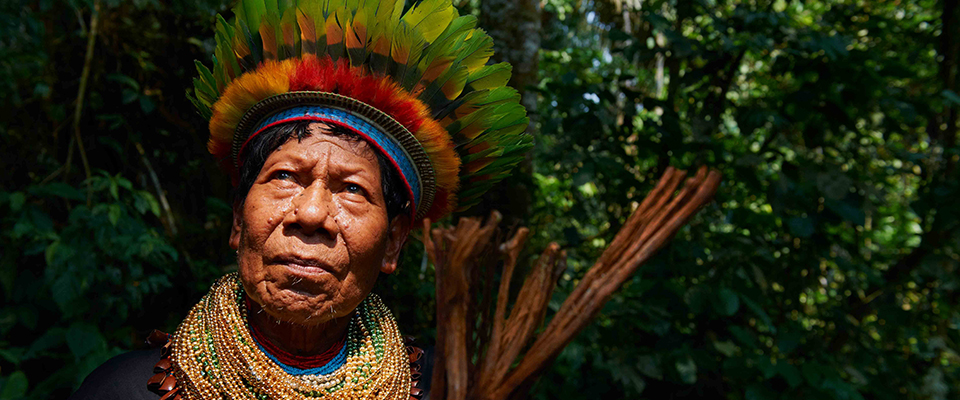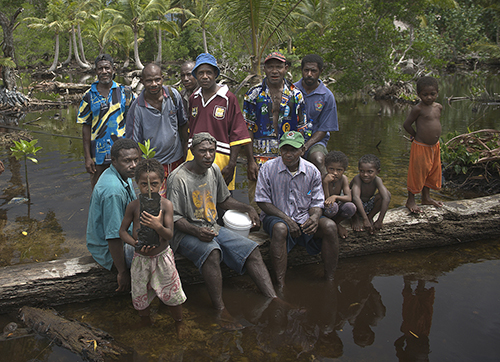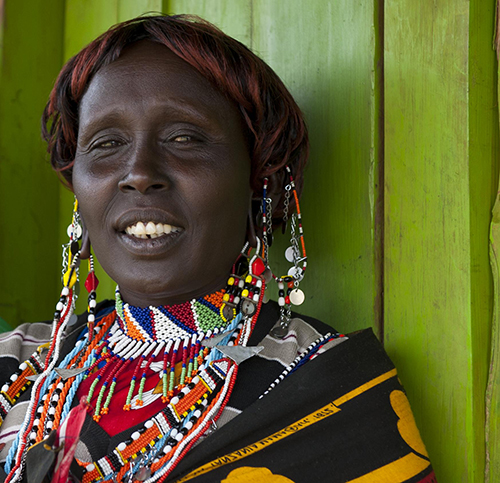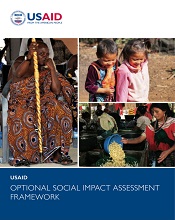- What We Do
- Agriculture and Food Security
- Democracy, Human Rights and Governance
- Democracy, Human Rights and Governance Strategy
- Supporting Free and Fair Elections
- Supporting Vibrant Civil Society & Independent Media
- Protecting Human Rights
- Promoting Accountability & Transparency
- Importance of Democracy, Human Rights, & Governance to Development
- COVID-19: Issues and Potential USAID Responses
- Countering Trafficking in Persons
- Global Labor Program
- Religious Freedom
- Youth Impact
- Economic Growth and Trade
- Education
- Environment and Global Climate Change
- Gender Equality and Women's Empowerment
- Global Health
- Humanitarian Assistance
- Transformation at USAID
- Water and Sanitation
- Working in Crises and Conflict
- U.S. Global Development Lab
Speeches Shim

Social Impact Assessment ![]() (pdf - 5 MB)
(pdf - 5 MB)
USAID's Policy on Promoting the Rights of Indigenous Peoples (PRO-IP) emphasizes the necessity for Social Impact Assessments, Inclusive Development Analyses, and a robust approach to consultation. These three tools are presented together in the Social Impact Assessment Toolkit to support the implementation of PRO-IP and to improve consultations and enhance partnerships with Indigenous Peoples. The goal is to safeguard against intended harm and to promote Indigenous Peoples’ own development priorities, including economic, environmental, health, and educational benefits.
Historically, Indigenous Peoples have been informed of rather than being involved in decisions and activities that may impact them. To address this, the PRO-IP and its tools make central the principles of engagement, partnership, and co-design with Indigenous Peoples throughout program design, implementation, and monitoring. Free, prior, and informed consent (FPIC) is the critical element of this engagement to ensure that Indigenous Peoples’ own development priorities are recognized and respected. FPIC is a principle that is enshrined in the United Nations' Declaration on the Rights of Indigenous Peoples.
This Social Impact Assessment Toolkit includes the Social Impact Assessment, the Inclusive Development Analysis, and the Consultation Handbook. Together they help practitioners to consider the potential impacts of a given activity on Indigenous Peoples who are stakeholders. This includes considering the opportunities presented by engaging with Indigenous Peoples in design and implementation as well as the risks of unintended impacts.
Social Impact Assessment (SIA)
Increase integration of Indigenous Peoples issues across all sectors and promote cross-sectoral approaches
 USAID does not have a standard framework for designing and implementing Social Impact Assessments (SIA). Practitioners should apply the guidance set forth in the Environmental Compliance Factsheet: Stakeholder Engagement in the Environmental and Social Impact Assessment Process (USAID’s “ESIA Guidance”) in order to identify risks and opportunities of implementing development activities near or within Indigenous Peoples’ territories. The ESIA is a short, user-friendly guide that can be complemented by more comprehensive SIAs that specifically target Indigenous Peoples, such as the Akwe: Kon Guidelines. Key steps in the SIA process include:
USAID does not have a standard framework for designing and implementing Social Impact Assessments (SIA). Practitioners should apply the guidance set forth in the Environmental Compliance Factsheet: Stakeholder Engagement in the Environmental and Social Impact Assessment Process (USAID’s “ESIA Guidance”) in order to identify risks and opportunities of implementing development activities near or within Indigenous Peoples’ territories. The ESIA is a short, user-friendly guide that can be complemented by more comprehensive SIAs that specifically target Indigenous Peoples, such as the Akwe: Kon Guidelines. Key steps in the SIA process include:
- Identifying: Listing all possible relevant groups, organizations, and peoples, with consideration for disaggregating stakeholder information in ways that improve representation;
- Analyzing: Understanding the various perspectives, values, and biases of stakeholders;
- Mapping: visualizing relationships as they relate to objectives and other stakeholders;
- Prioritizing: ranking relevance of stakeholder groups and identifying issues.
Missions should consider implementing an SIA alongside an environmental impact assessment (EIA) for any project with a reasonable likelihood of impacting Indigenous People or their territories. Applying an Indigenous Peoples' lens can be an expansion of existing efforts in the field and can contribute to a deeper assessment of potential social and environmental impacts on Indigenous Peoples. USAID’s ESIA Guidance has clear steps for Missions to begin engaging Indigenous Peoples in conversations around considerations relevant and/or unique to their communities; issues specific to Indigenous Peoples must be considered as part of any SIA.
A meaningful SIA process extends over the life of the program and includes a plan to regularly engage stakeholders and continually evaluate risks and opportunities. Effort should be taken to carefully manage expectations among stakeholders during the preliminary SIA process. Consultations should consider differential impacts, risks and benefits between men and women, marginalized groups, and across generations. Increasingly granular analysis may be warranted, on a case-by-case basis, to determine ways to most effectively mitigate risk if there is a high likelihood of impact on Indigenous Peoples.
At the conclusion of the SIA, missions should be able to identify:
- The focal Indigenous Peoples' communities
- Opportunities to engage Indigenous Peoples across the program cycle
- Risks to the communities that may result from programming, including the degree of risk (low/medium/high) and appropriate risk mitigation measures
- Issues and/or gaps with steps for further analysis
Other Resources
- Akwé: Kon Guidelines
- Whakatane Mechanism
- IUCN Environmental and Social Management System – Standard on Indigenous Peoples
- TerraLingua
- USAID’s Biodiversity Policy regarding Indigenous Peoples
- Indigenous Peoples Major Group for Sustainable Development
- Rights & Resources
- The Tenure Facility
- Ford Foundation
- Why Invest in Indigenous Lands?
- Land Governance Assessment Framework
- Landmark (Map)
- World Resources International Blog: 5 Maps on Indigenous Peoples’ Impact on the Environment
- Land Portal Map
- If Not Us Then Who? (Map)
Inclusive Development Analysis (IDA)
Inclusive Development Analysis with an Indigenous Peoples' Lens
An Inclusive Development Analysis (IDA) is an analytic tool to provide a better understanding of gaps between Indigenous Peoples and other households, communities, and the country(s) in which they reside, and to identify structural barriers and processes that can exclude Indigenous Peoples from full participation in society and development programs. Challenges to inclusion are commonly tied to land, territories and natural resources, and the IDA can be an important means of identifying tenure and governance issues and priorities in the context of a dynamic Program Cycle.
IDAs also provide information on potential differential impacts of development programs on Indigenous Peoples, and provide guidance and recommendations for increasing inclusivity and Indigenous Peoples' empowerment. In turn, program impact is deepened, and development outcomes are improved and made more sustainable. When used as part of the SIA toolkit supporting the PRO-IP, an IDA is one of the most important tools for integrating inclusive development into mission programming.
 To maximize effectiveness of an IDA, broad stakeholder engagement and robust consultations with diverse beneficiaries and stakeholders is essential. An IDA can be a standalone analysis, or can be incorporated as part of analyses missions already undertake. An IDA can be closely related to gender analyses; in mainstreaming gender analyses in development programming, it is important to consider the multiple identities of individuals including sex, gender, age and other demographic characteristics.
To maximize effectiveness of an IDA, broad stakeholder engagement and robust consultations with diverse beneficiaries and stakeholders is essential. An IDA can be a standalone analysis, or can be incorporated as part of analyses missions already undertake. An IDA can be closely related to gender analyses; in mainstreaming gender analyses in development programming, it is important to consider the multiple identities of individuals including sex, gender, age and other demographic characteristics.
However, there may be contexts in which it is appropriate to conduct a standalone IDA. To develop a standardized approach to the IDA process, USAID recommends the “domains model,” as outlined in the Agency’s Gender Analysis and the Additional Help for ADS201, as a useful framework.
An IDA should provide specific recommendations, based on the findings, on how to address concerns and needs of Indigenous Peoples through development programming. Opportunities and challenges to be included are often country and context-specific, but in general, IDAs should attempt to identify:
- Identity groups that are discriminated against, stigmatized, or similarly marginalized in the country;
- The landscape of identity-based inequality in the country, including access to assets, resources, opportunities, and services when compared with other groups;
- Drivers of marginalization and exclusion, motivations of key actors, and how those actors exert their influence;
- The potential risk to Indigenous Peoples that could result from program activities, and how programs can be designed to mitigate or minimize these;
- Opportunities to increase inclusion and consideration of the needs of these groups through programming
Ideally, an IDA will be an ongoing process over the course of the program cycle. In general, there are four stages where an IDA is most appropriate:
- Country or regional strategic planning
- Project design and implementation
- Activity design and implementation
- Monitoring, evaluation and learning
Other Resources
Consultation Handbook
Why consult with Indigenous Peoples?
 Consultation with Indigenous Peoples helps deepen the reach and improve the impacts and outcomes of development projects. A robust consultation process centered on the human rights of Indigenous Peoples and free, prior and informed consent (FPIC) helps manage financial and reputational risk for development organizations and their partners while helping to avoid harm to the communities. The Consultation Handbook aims to complement the PRO-IP and provide a framework for effective consultation that is consistent with industry best practices and human rights norms.
Consultation with Indigenous Peoples helps deepen the reach and improve the impacts and outcomes of development projects. A robust consultation process centered on the human rights of Indigenous Peoples and free, prior and informed consent (FPIC) helps manage financial and reputational risk for development organizations and their partners while helping to avoid harm to the communities. The Consultation Handbook aims to complement the PRO-IP and provide a framework for effective consultation that is consistent with industry best practices and human rights norms.
Consultations also serve as risk management tools and help to maximize the impact of development programming, and when conducted early and often, new opportunities often arise to advance development objectives and deepen cross-sectoral results. This can be achieved when the human rights of Indigenous Peoples are respected.
For more examples of the many benefits of working with Indigenous Peoples, see USAID’s PRO-IP, and links on this website to sector-by-sector resources.
Benefits of engaging Indigenous Peoples in meaningful consultation
- Democratizes development to be more participatory, inclusive, transparent, and accountable
- Co-Design: Different and more ideas of what development and progress can be
- Strengthens the inclusivity, sustainability, and local ownership of programming
- Possibility for high development impact for vulnerable and marginalized groups
- Builds deeper relationships to improve understanding and trust with all stakeholders in the development enterprise
- Benefit from traditional knowledge and practices that complement USAID’s development goals
Risks of not engaging with Indigenous Peoples
- Much greater chance of violating human rights with programming
- Financial risk to USAID investments (i.e. project failure or cancellation due to backlash)
- Invites reputational risk to USAID
- Opens USAID to legal risk from grievances
- Can cause impoverishment, disrupt communities, or cause other unanticipated damage
- Can aggravate local conflicts
Factors and Considerations for Identifying Indigenous Peoples
- self-identification as a distinct social and cultural group;
- recognition of this identity by others;
- historical continuity with pre-colonial and/or pre-settler societies;
- collective attachment to territories and their natural resources;
- customary social, economic, or governance systems that are distinct;
- distinct language or dialect; and/or
- resolve to maintain and reproduce their ancestral environments and systems as distinctive peoples and communities.
Note that not all Indigenous Peoples share all of these characteristics
When should Indigenous Peoples be consulted?
Early and Often — Consultations should occur early and often in the USAID Program Cycle in order to identify new opportunities to advance development objectives and deepend cross-sectoral results.
Strategy Building and Project and Activity Design — The Office of Acquisition and Assistance has determined that OUs should consult with Indigenous Peoples in the strategy and design phases as long as there is no likelihood that a participating organization will be a potential applicant for the resulting procurement action.
Project Implementation and Monitoring — Engagement with Indigenous Peoples should be on-going during project implementation to help inform and re-align objectives and impacts. Such engagements should be used to maintain strong relationships with affected communities over the life of the project.
Essential elements of a consultation process
- Identification of Indigenous Peoples in accordance with PRO-IP and international standards
- Communication with stakeholders early and often
- Good faith consultations are undertaken through representative institutions and in accordance with traditional decision making structures and mechanisms
- Stakeholders have a meaningful opportunity to influence the planning, implementation, and development processes
Other Resources
- UN-ILO 169 – Convention on Indigenous Peoples
- UN-Food and Agriculture Organization's FPIC Manual
- UN Declaration on the Rights of Indigenous Peoples Training Materials
- Voluntary Guidelines on Compulsory Resettlement
- Rainforest Alliance Guide for FPIC Process
- UN Reducing Emissions from Deforestation and forest Degradation Guidelines on FPIC
- Oxfam FPIC Training Resources


Comment
Make a general inquiry or suggest an improvement.